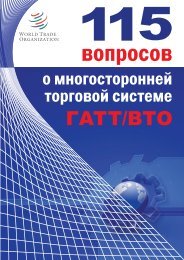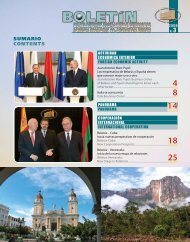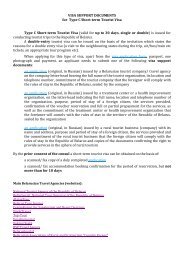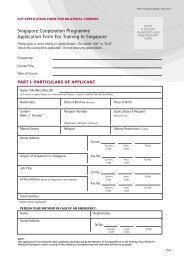Human Development Report 2013 - UNDP
Human Development Report 2013 - UNDP
Human Development Report 2013 - UNDP
You also want an ePaper? Increase the reach of your titles
YUMPU automatically turns print PDFs into web optimized ePapers that Google loves.
BOX 2.1The South’s integration with the world economy and human developmentIn a sample of 107 developing countries over 1990–2010, about 87% canbe considered globally integrated: they increased their trade to output ratio,have many substantial trading partnerships1 and maintain a high trade tooutput ratio relative to countries at comparable income levels. 2 All thesedeveloping countries are also much more connected to the world and witheach other: Internet use has expanded dramatically, with the median annualgrowth in the number of users exceeding 30% between 2000 and 2010.While not all globally integrated developing countries have made rapidgains in <strong>Human</strong> <strong>Development</strong> Index (HDI) value, the converse is true. Almostall developing countries that made the most improvement in HDI value relativeto their peers between 1990 and 2012 (at least 45 in the sample here)have integrated more with the world economy over the past two decades;their average increase in trade to output ratio is about 13 percentage pointsgreater than that of the group of developing countries with more modestimprovement in HDI value. This is consistent with earlier findings that countriestend to open more as they develop. 3The increasingly integrated countries with major improvement in HDIvalue include not only the large ones that dominate the headlines, but alsodozens of smaller and least developed countries. Thus they constitute alarger and more varied group than the emerging market economies oftendesignated by acronyms, such as BRICS (Brazil, Russian Federation, India,China and South Africa), IBSA (India, Brazil and South Africa), CIVETS(Colombia, Indonesia, Viet Nam, Egypt, Turkey and South Africa) and MIST(Mexico, Indonesia, South Korea [Republic of Korea] and Turkey).The figure below plots improvement in HDI value 4 against the changein trade to output ratio, an indicator of the depth of participation in globalmarkets. More than four-fifths of these developing countries increased theirtrade to output ratio between 1990 and 2012. Among the exceptions in thesubgroup that also made substantial improvement in HDI value are Indonesia,Pakistan and Venezuela, three large countries that are considered global playersin world markets, exporting or importing from at least 80 economies. Twosmaller countries whose trade to output ratio declined (Mauritius and Panama)continue to trade at levels much higher than would be expected for countriesat comparable income levels. All countries that had substantial improvementin HDI value and increased their trade to output ratio between 1990 and 2012are highlighted in the upper right quadrant of the figure. Countries in the lowerright quadrant (including Kenya, the Philippines and South Africa) increasedtheir trade to output ratio but made modest improvement in HDI value.<strong>Human</strong> progress and trade expansion in the SouthRelative improvement in HDI value, 1990–20120.30.20.10–0.1ChinaTurkey MexicoBrazilGhanaBangladeshIndia–0.2–0.3–0.4–0.6 –0.4 –0.2 0.0 0.2 0.4 0.6 0.8 1.0 1.2Change in trade to output ratio, 1990–2010High HDI improvers, globally integratedModest HDI improvers, globally integratedOthers1. Bilateral trade exceeding $2 million in 2010–2011.2. Based on results from a cross-country regression of trade to GDP ratio on income per capita that controls for population and landlockedness.3. See Rodrik (2001).4. Relative HDI improvement is measured by residuals from a regression of the change in the log of HDI value between 1990 and 2012 on the log of initial HDI value in 1990. Five countries with black dots in the upperleft quadrant made substantial improvement in HDI value but reduced their trade to output ratio between 1990 and 2010, though they either maintained a large number of substantial trading ties globally or tradedmore than predicted for countries at comparable levels of income per capita. Countries with open circles in the upper right and lower right quadrants had modest relative improvement in HDI value between 1990 and2012 but increased their trade to output ratio or maintained a large number of substantial trading ties.Source: HDRO calculations; trade to output ratios from World Bank (2012a).$200 billion to $3 trillion. 10 But trade has alsoincreased for many other countries. In 2010, merchandiseexports per capita from Sub-SaharanAfrica were more than twice those from India. 11In 1995–1996 Thailand had around 10 tradingpartners to which it exported more than $1 billionin goods each; just 15 years later it had threetimes as many, spread across the globe (map 2.1). 1244 | HUMAN DEVELOPMENT REPORT <strong>2013</strong>
















